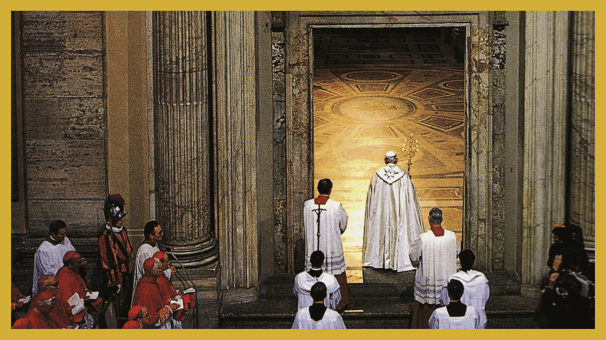What is the Jubilee
Index
What Does the Jubilee Represent?
What Is the History of the Jubilee?
When Is the Jubilee Celebrated?
When Does the 2025 Jubilee Begin and How Long Will It Last?
Theme and Vision of the 2025 Jubilee
The Jubilee, or Holy Year, is a cornerstone in the spiritual life of the Catholic Church—an extraordinary occasion for reflection, prayer, and renewal. During the Jubilee, the faithful are encouraged to take part in ceremonies and pilgrimages, not only as acts of devotion but also as expressions of a global community united in faith. This event goes beyond a mere religious observance; it becomes a bridge between the divine and the human, offering believers a profound opportunity to experience forgiveness and mercy.


What Does the Jubilee Represent?
The Jubilee, or Holy Year, is an extraordinary and solemn event in the tradition of the Catholic Church, a special year of grace and reconciliation that allows the faithful to receive forgiveness of sins through pilgrimage, participation in the sacraments, and acts of charity. The term Jubilee originates from the Hebrew word “Jobel”, referring to the ram's horn used in sacred ceremonies during the Jewish Jubilee. In Christianity, the Jubilee offers an opportunity to draw closer to God, obtain a plenary indulgence, and renew one’s spiritual life.
During the Holy Year, the Church invites all the faithful to embark on a journey of conversion, providing a period for deep reflection and penance. Through the sacraments of Confession and the Eucharist, pilgrims can obtain remission of temporal punishment due to sins already forgiven, experiencing a profound renewal of their spiritual lives
What is the History of the Jubilee?
The Jubilee has deep roots, tracing back to the ancient Jewish tradition of the Yovel, a time every fifty years for rest for the land, liberation for slaves, and restitution of property. This tradition emphasized equity, justice, and compassion—values that were embraced and reinterpreted in the Catholic tradition, transforming the Jubilee into a time of grace, forgiveness, and spiritual renewal.
In the Christian context, the Jubilee was inaugurated by Pope Boniface VIII in 1300, inspired by both the Jewish tradition and the Indulgence of the Hundred Years, an ancient practice of pilgrimage and penance. Since then, the Jubilee has been celebrated at regular intervals (initially every hundred years, later reduced to fifty, and eventually to twenty-five years with exceptions for extraordinary Jubilees), drawing millions of pilgrims to Rome.
When is the Jubilee celebrated?
The Jubilee, in its historical and liturgical cycle, is observed in two forms: ordinary and extraordinary, each with its own identity and purpose, yet both aimed at renewing the faith and commitment of believers. The Ordinary Jubilee is celebrated every 25 years, a rhythm that ensures each generation the opportunity to experience this time of grace and mercy at least once. During these years, the Holy Doors of Rome's major basilicas are opened, symbolizing access to God's grace and serving as an invitation to personal and communal renewal.
On the other hand, the Extraordinary Jubilee is proclaimed by the Pope to commemorate events of particular significance or to address urgent pastoral needs, without following a fixed schedule. A recent example is the Jubilee of Mercy declared by Pope Francis in 2015, a year dedicated to reflecting on and living out God's mercy more intensely in a world often marked by conflict and indifference.
Despite differences in their origins and timing, these celebrations share the common goal of drawing the faithful closer to divine mercy and to the tangible experience of the Church as a community of welcome, forgiveness, and charity.
When Does the 2025 Jubilee Begin and How Long Will It Last?
The upcoming Ordinary Jubilee will begin on December 24, 2024, with the solemn opening of the Holy Door at St. Peter’s Basilica. This event marks the official start of a year during which the faithful are invited to visit Rome's major basilicas to receive plenary indulgence. The Jubilee will conclude in January 2026, offering a full year for pilgrims to undertake their spiritual journeys and reflect on their faith.
Theme and Vision of the 2025 Jubilee
The theme of the 2025 Jubilee, Pilgrims of Hope, resonates deeply in a time of global and personal challenges, uncertainties, and change. It is not just an invitation to renew confidence in the future but also a call to act as builders of hope—witnesses of steadfast optimism rooted in faith.
In an era where hope may feel fragile, the Jubilee encourages the faithful to rediscover and reaffirm their Christian hope, not as mere optimism but as a theological virtue that lights the way even in the darkest moments. Pilgrims of hope are called to be lights in the world, bringing the Gospel’s message through concrete acts of charity, justice, and solidarity.
The theme also invites reflection on how Christian hope can shape daily life and interactions with the world, inspiring renewed commitment to caring for creation, promoting peace, and fostering a more just and fraternal society. The Jubilee of 2025 reaffirms that hope is not an elusive dream but a tangible force that motivates action and sustains Christian engagement in the world.
This Holy Year is a call to embrace the vocation of hope with renewed fervor, inviting every believer to embark on a journey—one that, despite trials and deserts, is guided toward the luminous goal of full communion with God and others. It is a reminder that every step taken in faith brings us closer to realizing God’s Kingdom.
Drop us a line
Follow us
Discover the Jubilee
Experience the Jubilee
Jubilee locations
Get ready for the Jubilee
Rome and the Jubilee
